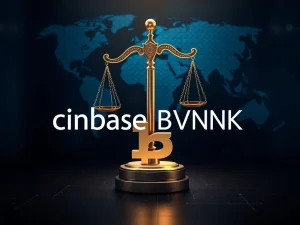Multicurrency Stablecoins: Crucial Innovations Revolutionize Crypto’s Dollar Dominance

The cryptocurrency landscape stands at a pivotal moment. For years, US dollar-pegged stablecoins have formed the bedrock of crypto’s financial infrastructure. They provided essential liquidity and stability. However, this dominance has also created a singular point of exposure. Now, a new era is emerging. Regulated multicurrency stablecoins are poised to challenge this long-standing paradigm. This shift promises to diversify the market and enhance its resilience. It represents a crucial evolution for the entire crypto ecosystem.
The Enduring Grip of Dollar Dominance on Crypto
Stablecoins initially served as a vital tool for crypto traders. They offered a reliable bridge between volatile digital assets and traditional fiat currencies. By pegging their value to the US dollar, these tokens facilitated seamless trading. They created an always-on liquidity pool. Over time, their role expanded significantly. Dollar-pegged coins now dictate prices, collateral standards, and risk appetite within the crypto space. This has established a powerful, on-chain financial layer. Jamie Elkaleh, chief marketing officer at Bitget Wallet, highlights a significant danger here. Without credible, well-regulated alternatives, the US dollar’s dominance will become permanently embedded in crypto’s foundation. This dependency carries inherent risks.
This deep integration means crypto liquidity closely mirrors US interest rates and policy. Consequently, market drawdowns amplify when Treasury markets face instability. Washington’s policy shocks directly impact decentralized finance (DeFi). Dollar tokens have already demonstrated this transmission of traditional finance conditions into crypto. Reserve assets typically reside in US government money markets. Therefore, crypto liquidity fluctuates with US rates. This financial plumbing is efficient and transparent. Yet, it concentrates macro exposure through a single sovereign’s money markets. Viewing this dependency as ‘neutral’ is a choice. The industry must correct it as it builds the next generation of market structures. Diversification is key to mitigating this systemic risk. It will create a more robust and independent global crypto economy.
Europe’s Strategic Push for Euro Stablecoins and Crypto Regulation
Europe actively addresses the challenge of dollar dominance. Policymakers recognize that the euro must feature prominently in on-chain order books. This is essential for true strategic autonomy. The European Union’s Markets in Crypto-Assets (MiCA) regulation provides a clear framework. It sets standards for stablecoin issuance and operation. This landmark legislation aims to foster a secure and transparent market. It encourages the development of euro-native financial rails. MiCA-compliant stablecoins like EURC and EURCV are emerging. These initiatives provide the necessary regulatory plumbing. However, deliberate market-making is still crucial. This will seed euro books and establish clear liquidity at depth. Regulators should actively support these efforts. They can underwrite liquidity rather than simply publishing guidelines. Otherwise, ‘strategic autonomy’ remains just a slogan. The European Central Bank (ECB) has openly voiced its concerns. Dollarized stablecoin rails weaken euro autonomy. Policy must therefore create strong euro-native alternatives.
The EURAU stablecoin represents an early test. Its success hinges on becoming a base pair with substantial liquidity. This means deep order books and consistent trading volume. Europe is not just admiring the problem; it is actively shaping solutions. The regulatory clarity provided by MiCA is a significant step. It offers a secure environment for issuers and users. This proactive approach aims to reduce reliance on external currencies. It strengthens the euro’s position within the digital economy. This will ultimately enhance the stability and independence of the European financial system. These developments mark a turning point. They show how regulatory policy can directly translate into tangible market liquidity. This creates a more balanced global stablecoin ecosystem.
Japan’s Emerging Role in Multicurrency Stablecoins
Japan is also advancing its own initiatives. It seeks to diversify the stablecoin landscape. Fintech group Monex actively prepares a yen-backed stablecoin. This signals growing interest from established financial players. Furthermore, JPYC recently received regulatory approval. This marks one of Asia’s first regulated fiat-backed tokens. These developments are significant. They demonstrate Japan’s commitment to fostering innovation within a regulated framework. However, mere approval is not enough. A JPY token must achieve broad utility. It needs to facilitate remittances and supplier payments. It must also appear as deep base pairs on major exchanges. Without widespread distribution and robust transparency, it risks remaining a compliant pilot project. Strict reserve transparency is paramount. Broad distribution through exchanges, payment service providers (PSPs), and wallets is equally vital. These steps will ensure the yen stablecoin’s success. They will make it a credible alternative to dollar-pegged options.
Japan’s regulatory environment offers a promising pathway. It encourages responsible growth in the digital asset sector. The focus on clear rules and consumer protection builds trust. This trust is essential for institutional adoption. As these yen-backed stablecoins gain traction, they will contribute to global multicurrency stablecoins. This diversification reduces concentration risk. It also offers more choices for users and businesses. Japan’s efforts underscore a global trend. Nations are actively seeking to integrate their national currencies into the digital economy. This move promotes financial innovation while maintaining sovereign control. It also enhances regional financial stability.
Hong Kong: A Proving Ground for Non-USD Rails and DeFi Liquidity
Hong Kong’s new licensing regime for stablecoin issuers holds immense importance. It offers a supervised pathway for non-USD tokens. This framework mandates enforceable reserves, clear redemptions, and comprehensive disclosures. These are precisely the constraints Europe and Japan require for Asian trading hours. The regime initially focuses on the Hong Kong dollar. However, its design can accommodate the offshore yuan (CNH). This makes Hong Kong a practical bridge for an offshore-yuan pilot. This pilot can be carefully monitored and scaled. Success in Hong Kong will depend less on code. It will hinge more on effective policy implementation. Currently, CNH liquidity pools are relatively shallow. Therefore, a licensed CNH token would provide a valuable corridor. This corridor can function until liquidity widens and hedging costs decrease. Hong Kong’s strategic position makes it ideal for this role. It connects East and West, offering a robust regulatory environment.
The Hong Kong framework sets a high bar for operational standards. It ensures investor protection and market integrity. This approach aligns with global efforts to bring crypto regulation into mainstream finance. By providing a secure environment for non-USD stablecoins, Hong Kong can foster significant growth. It offers a model for other jurisdictions considering similar initiatives. This move enhances regional financial stability. It also positions Hong Kong as a leader in digital asset innovation. The ability to supervise and scale CNH tokens is particularly noteworthy. It could unlock new avenues for trade and finance within Asia. This further reduces reliance on the US dollar. Ultimately, Hong Kong’s regime provides a critical testbed. It will demonstrate whether non-USD rails can truly clear transactions at scale. This is vital for the broader adoption of multicurrency stablecoins.
Catalysts for Shifting DeFi Liquidity and Ending Dollar Dominance
Non-USD tokens must become primary units for price discovery. Only then will they truly matter. This requires several critical elements. First, daily reserve disclosures are essential. Independent attestations must meet or exceed USDT/USDC standards. This ensures transparency and builds trust. Second, native multichain issuance is crucial. It enables wrapper-free settlement across various blockchain networks. This enhances efficiency and reduces friction. Third, hard redemption Service Level Agreements (SLAs) are necessary. These allow institutions to comfortably fund operations in euros or yen overnight. These technical and operational standards are non-negotiable for institutional adoption. They provide the confidence needed for large-scale integration. Exchanges also play a vital role in this transition. They should actively list non-USD base pairs. Furthermore, they must direct incentives towards these pairs. This is important even if early spreads are wider. This encourages price discovery to occur independently of the dollar.
Europe has already established two key pieces of this puzzle. It boasts a regulated issuer pipeline. Its central bank openly advocates for euro rails. Hong Kong supplies the third crucial element. It provides a venue that can license and supervise issuers serving Asian trading hours. This comes with clear expectations on reserves and conduct. These combined elements can gradually chip away at the dollar’s on-chain monopoly. This does not mean the dollar disappears. Rather, it promotes a more diversified and resilient ecosystem. The shift towards greater DeFi liquidity in non-USD assets will enhance global financial stability. It offers more choices for users and reduces systemic risk. This collaborative effort across continents highlights a global commitment to a truly decentralized and multicurrency future for finance.
The Broader Vision: A Multicurrency Future for Crypto
Dollar stablecoins will remain a significant part of the crypto landscape. Their established infrastructure and widespread use are undeniable. However, a single-currency base layer makes crypto more fragile. It limits its true potential for openness. Europe’s EURAU approval clearly demonstrates how policy can effectively generate liquidity. Japan’s wave of stablecoin licensing adds crucial regional depth. Hong Kong’s robust regime supplies the ideal testbed. It will prove whether non-USD rails can clear transactions in significant volumes. These initiatives collectively foster a more diversified and resilient crypto financial system. If euro and yen liquidity consolidates on major exchanges, a transparent, licensed CNH token could follow. This would lead to a significant shift. Pricing, collateral, and funding on-chain would diversify beyond a single sovereign’s money markets. This reduces concentration risk without sacrificing speed or composability. The next crypto cycle will reward issuers and jurisdictions that proactively turn compliance into competitive foreign exchange liquidity. Conversely, it will penalize those that passively rebuild dollar dominance. The future of crypto lies in embracing a truly global, multicurrency foundation. This will unlock greater innovation and stability for all participants. Opinion by: Jamie Elkaleh, chief marketing officer at Bitget Wallet. This article is for general information purposes and is not intended to be and should not be taken as legal or investment advice. The views, thoughts, and opinions expressed here are the author’s alone and do not necessarily reflect or represent the views and opinions of Crypto News Insights.







